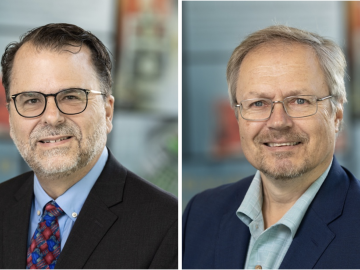
Filter News
Area of Research
- (-) Clean Energy (60)
- (-) National Security (23)
- (-) Neutron Science (103)
- (-) Nuclear Science and Technology (13)
- Advanced Manufacturing (3)
- Biology and Environment (20)
- Building Technologies (3)
- Computational Biology (1)
- Computational Engineering (1)
- Computer Science (8)
- Electricity and Smart Grid (1)
- Functional Materials for Energy (1)
- Fusion and Fission (4)
- Isotopes (25)
- Materials (57)
- Materials for Computing (6)
- Supercomputing (52)
News Topics
- (-) Artificial Intelligence (25)
- (-) Buildings (38)
- (-) Isotopes (6)
- (-) Machine Learning (21)
- (-) Neutron Science (103)
- (-) Transformational Challenge Reactor (5)
- 3-D Printing/Advanced Manufacturing (87)
- Advanced Reactors (16)
- Big Data (13)
- Bioenergy (32)
- Biology (18)
- Biomedical (20)
- Biotechnology (6)
- Chemical Sciences (16)
- Clean Water (10)
- Climate Change (25)
- Composites (18)
- Computer Science (52)
- Coronavirus (23)
- Critical Materials (9)
- Cybersecurity (25)
- Decarbonization (35)
- Energy Storage (75)
- Environment (64)
- Exascale Computing (2)
- Fossil Energy (3)
- Frontier (3)
- Fusion (11)
- Grid (44)
- High-Performance Computing (12)
- Hydropower (2)
- Materials (47)
- Materials Science (52)
- Mathematics (3)
- Mercury (3)
- Microelectronics (1)
- Microscopy (10)
- Molten Salt (5)
- Nanotechnology (18)
- National Security (37)
- Net Zero (3)
- Nuclear Energy (45)
- Partnerships (16)
- Physics (12)
- Polymers (12)
- Quantum Computing (1)
- Quantum Science (9)
- Renewable Energy (1)
- Security (16)
- Simulation (4)
- Space Exploration (10)
- Statistics (1)
- Summit (10)
- Sustainable Energy (69)
- Transportation (70)
Media Contacts

Stephen Kowalski and Mikael Salonvaara received the Distinguished Service Award, which salutes members who have served the society with distinction in chapter, regional and society activities.

Kashif Nawaz, distinguished researcher and section head for Building Technologies Research at the Department of Energy’s Oak Ridge National Laboratory, has been named a Fellow of the American Society of Mechanical Engineers, or ASME.

The "SNS LEGO Model Middle School Outreach Program" invites middle school students to build a LEGO model of the SNS, a major scientific accelerator. This engaging initiative aims to teach students about STEM careers and the inner workings of the SNS through hands-on construction and interactive lessons. Launching next spring, the program seeks to inspire interest in science and engineering among young learners.

Scientists at ORNL have developed 3-D-printed collimator techniques that can be used to custom design collimators that better filter out noise during different types of neutron scattering experiments

Digital twins are exactly what they sound like: virtual models of physical reality that continuously update to reflect changes in the real world.

How do you get water to float in midair? With a WAND2, of course. But it’s hardly magic. In fact, it’s a scientific device used by scientists to study matter.

Karen White, who works in ORNL’s Neutron Science Directorate, has been honored with a Lifetime Achievement Award.

ORNL is home to the world's fastest exascale supercomputer, Frontier, which was built in part to facilitate energy-efficient and scalable AI-based algorithms and simulations.

ORNL researchers demonstrated that an additive made from polymers and electrolytes improves the thermal performance and stability of salt hydrate phase change materials, or PCMs, a finding that could advance their integration into carbon-reducing heat pumps.

In fiscal year 2023 — Oct. 1–Sept. 30, 2023 — Oak Ridge National Laboratory was awarded more than $8 million in technology maturation funding through the Department of Energy’s Technology Commercialization Fund, or TCF.


